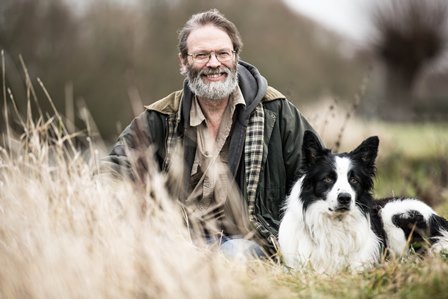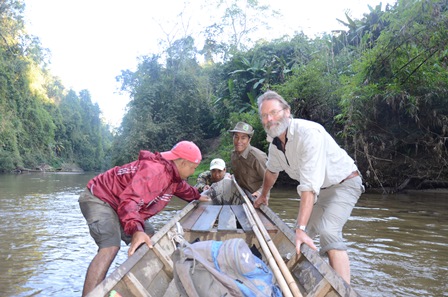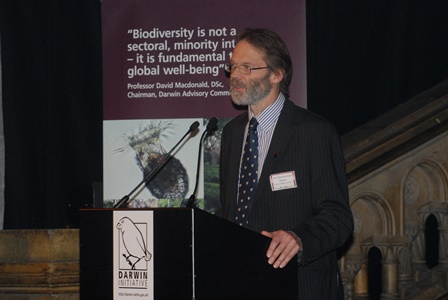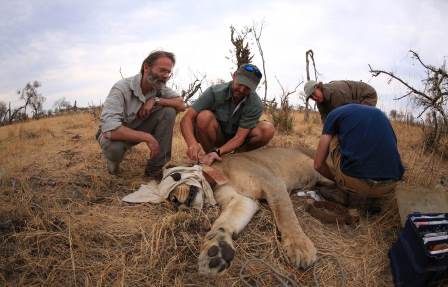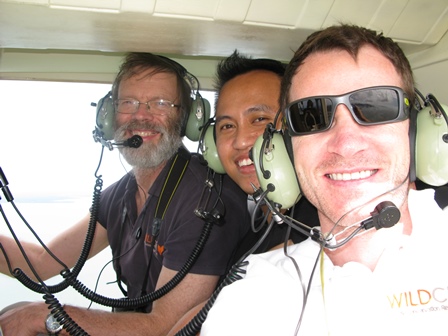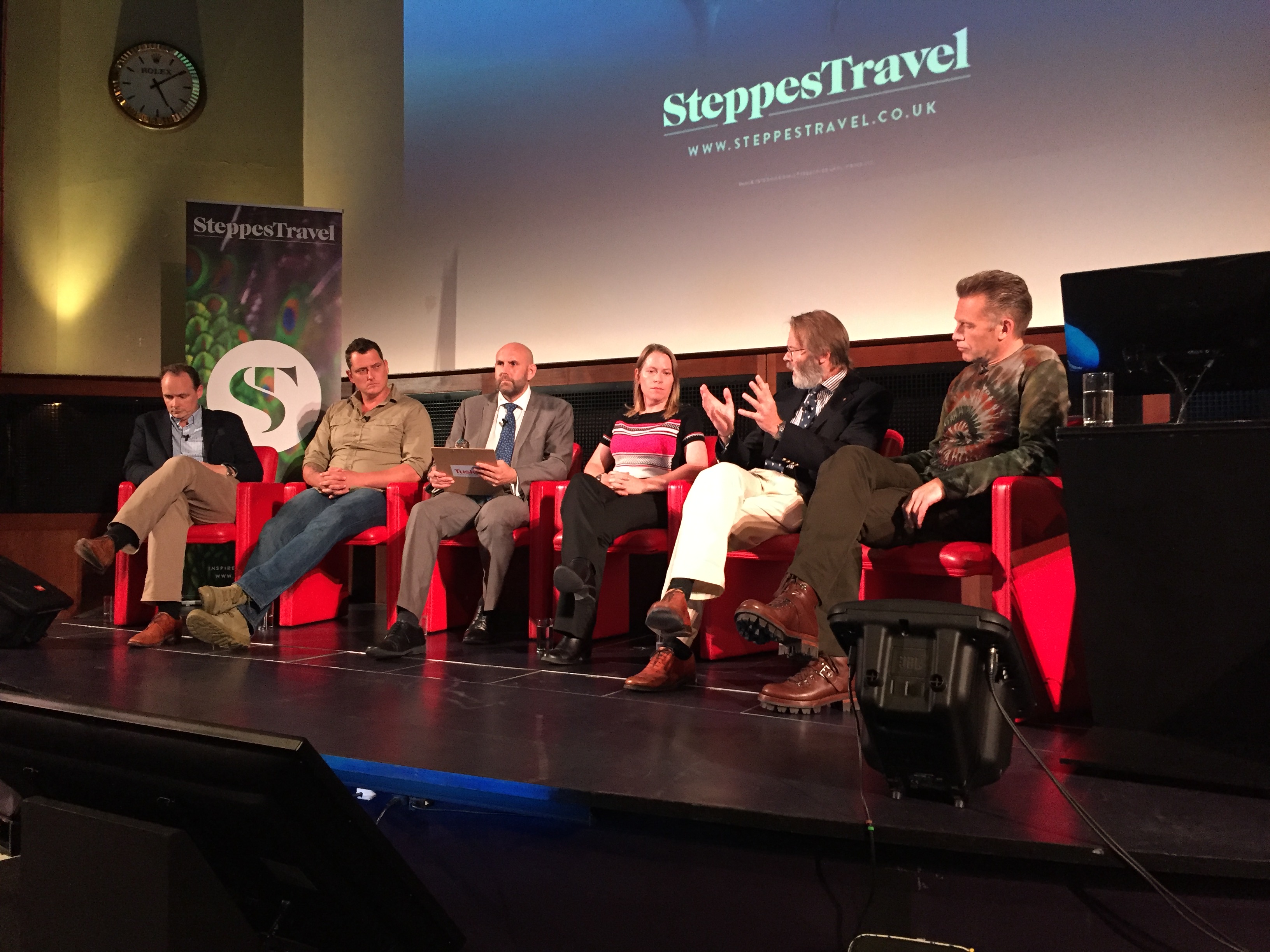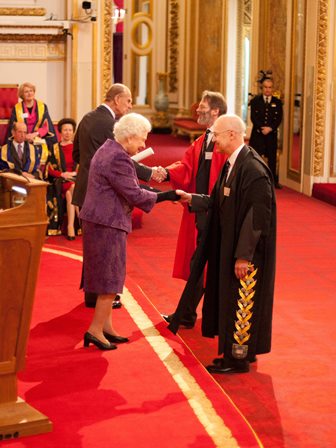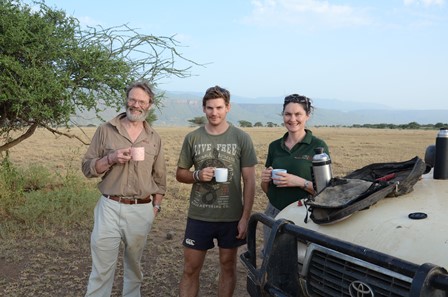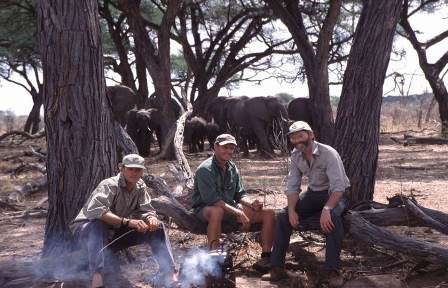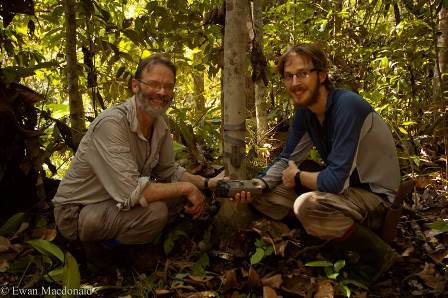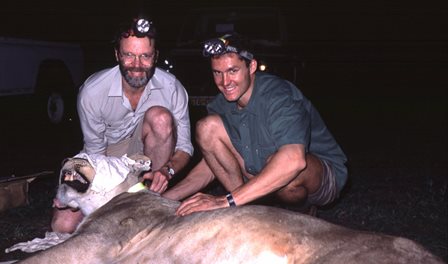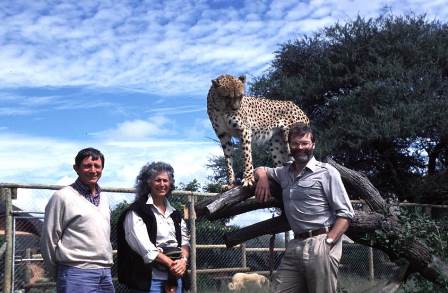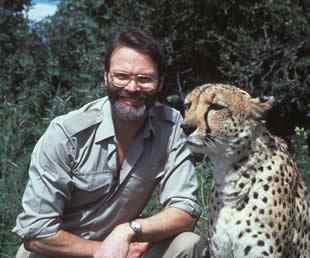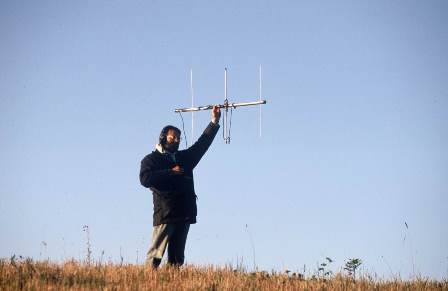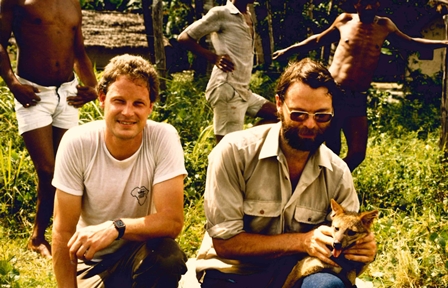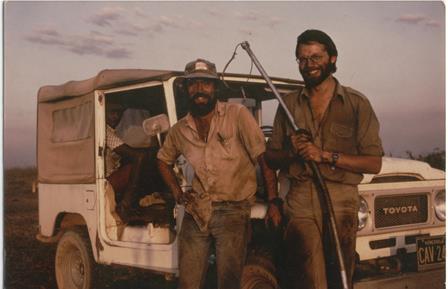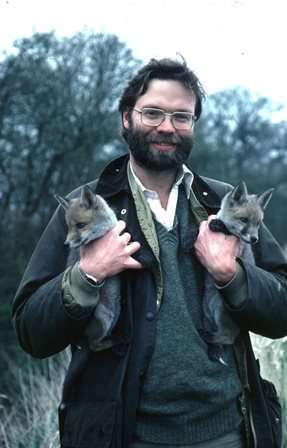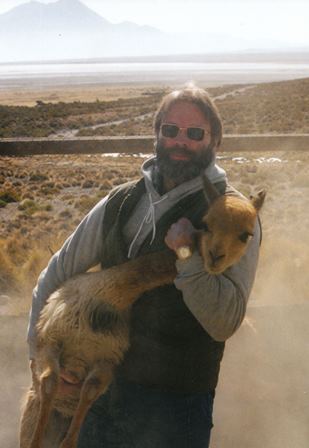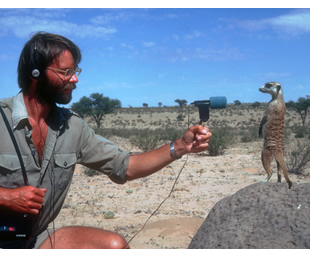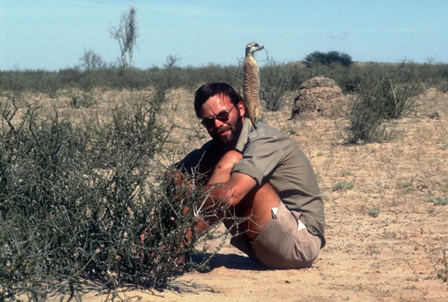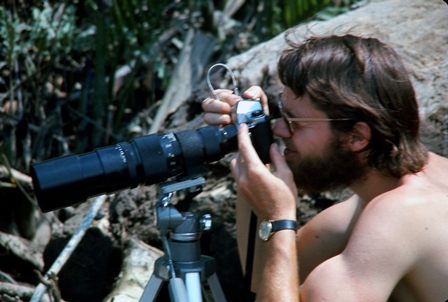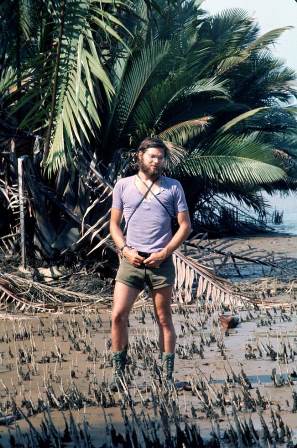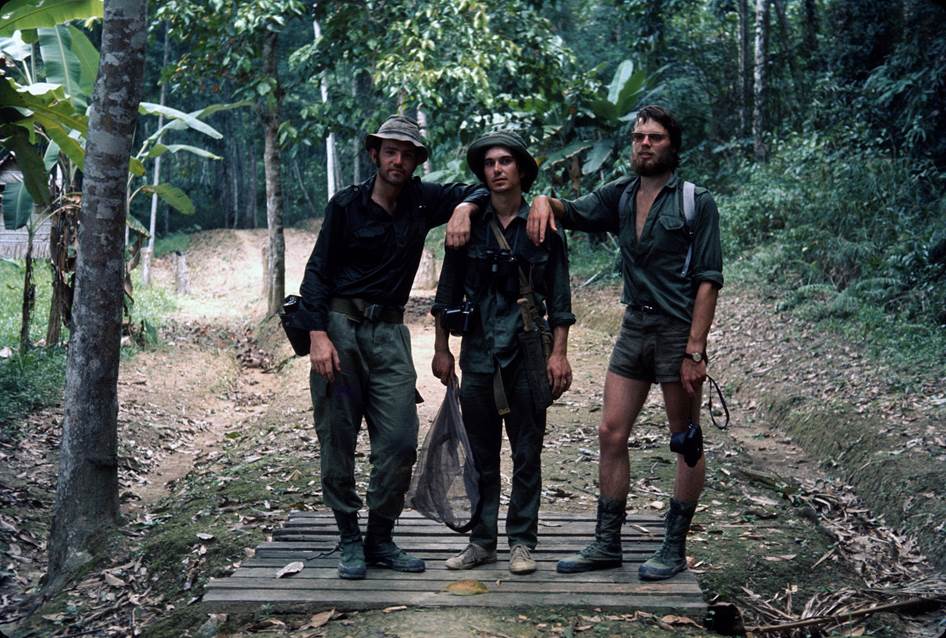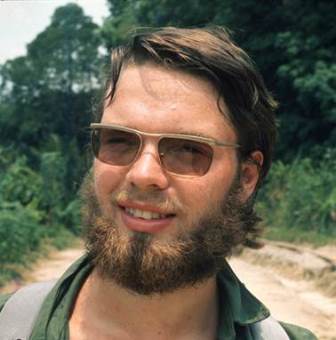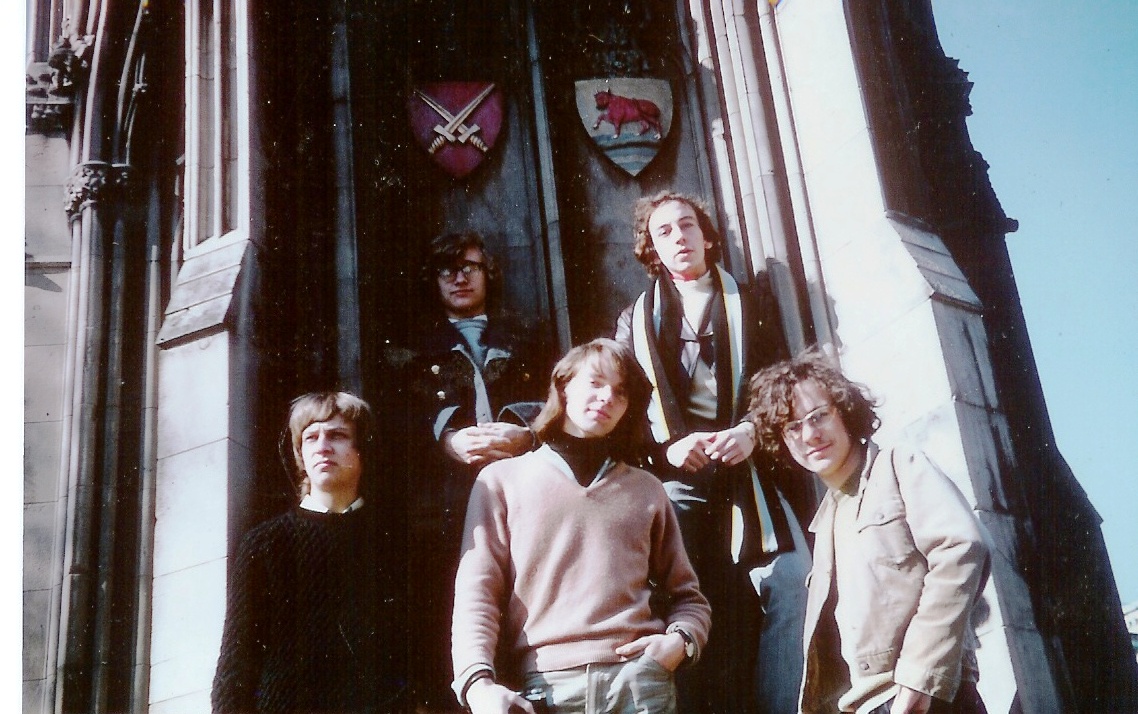Professor David Macdonald CBE DSc FRSE
Research Fellows
Founder, WildCRU
Wildlife Conservation Fellow, Lady Margaret Hall
Video created and provided by United for Wildlife: www.unitedforwildlife.org/
In brief an accurate, if somewhat colourless biography, might say that I am Oxford University’s first Professor of Wildlife Conservation. It might also note that I conceived, and implemented the appeal which led, after all too many years of struggle, to the foundation of the Wildlife Conservation Research Unit in 1986. In addition to directing the WildCRU I hold a Research Fellowship in Wildlife Conservation at Lady Margaret Hall, and was deeply involved in creating this, the first Fellowship in any British university dedicated to biological conservation, just as the WildCRU was also the first such research unit.
Selected as a Finalist for the 2018 Award for Conservation Excellence, David Macdonald gave this short interview of the work of the WildCRU and his vision for the future of wildlife conservation
My scientific background is in behavioural ecology, with an emphasis on carnivores, although my research has spanned published studies on organisms from moths to penguins and even, occasionally, plants. As both the WildCRU, and the whole field of conservation, have evolved, our work has become inter-disciplinary. More recently my biological writings are increasingly enmeshed in issues of environmental policy, economics and research strategy.
These studies span habitats as pristine as tropical forests and montane plateaux and as transformed by man as agro-ecosystems. Themes as diverse as endangered species, invasives, human-wildlife conflict, wildlife diseases and payments for ecosystem services, all fit within the WildCRU’s wider aim. The aim, as it was in 1986, is to undertake original research on aspects of fundamental biology relevant to solving practical problems of wildlife conservation and environmental management. The research we produced can thus underpin policy formation and public debate of the many issues that surround the conservation of wildlife and its habitats.
At greater length of course, the reality is much more colourfully haphazard than the foregoing (a fuller, and even more palidly formulaic, version can be found in, “Who’s Who”).
The reality involves a roller-coaster journey as exciting and improbable as it has been turbulent. The story starts with a little boy from a Glaswegian family, with a penchant for taming animals, and childhood recollections of pilfering plaster of paris from his, medical father’s Surgery to make castes of fox footprints in the sandy bunkers of golf courses (this and other early adventures are elaborated in Running with the Fox, 1987). Zeal for communicating the science of natural history developed into parallel career writing and film-making alongside research in behavioural ecology which was just coming of age on the academic scene.
Perhaps it was the background of a medical family that made me so convinced that this wondrously enthralling new science could and should be made useful I’m fond of remarking that while it’s difficult enough to be interesting, its much harder to be useful I was scarcely twenty when this thought became my cause celebre, and not much older when it took the shape of a dream that has been realised in the WildCRU. That this has become a reality is the result of almost unimaginable luck and the support of a cluster of remarkable people for example, academically, Niko Tinbergen and Hans Kruuk who nurtured my youthful vulpine obsessions, visionaries like Sir Richard Southwood and Sir David Attenborough who supported my early efforts to create the WildCRU, friends like James Teacher and Terry Collins amongst those who put their money and that of others where my mouth was, and lead us ultimately to our centre at Tubney House, and latterly Tom and Dafna Kaplan who have now made possible the opening of our new training centre for inspirational young conservationists from the developing world the WildCRU Panthers. This story, and the characters that populate it, has more than self-indulgent personal interest because it so closely coincides with the emergence of conservation science as an academic profession.
Teaching
The greatest strength of the WildCRU, and my most compelling teachers, are my graduate students. I have supervised over 60 successful Oxford doctorates, and several more in other universities in the UK and overseas. I am immensely proud that all my former doctoral students have secured worthwhile and generally influential jobs, almost invariably in the biological sector. The subjects have included the behavioural ecology, social systems and conservation and management of mammals, together with the epidemiology of wildlife diseases, animal welfare and agro-ecology (including studies of birds, butterflies and other invertebrates). To the superficial eye these projects might seem unconnected, but in fact they all link up to a whole that is calculated to be more than the sum of its parts. Academically, I am very proud to have been the A.D. White Professor-at-Large at Cornell University, a Visiting Professor at Imperial College and Liverpool University, and an Emeritus Fellow of the IUCN’s Survival Commission.
Hands on Conservation
Those who check the about WildCRU section will find that in addition to our Research Core, we also focus on Research Plus. That is, there is a human dimension to every WildCRU project and without the commitment and cooperation of local people, conservation is virtually impossible. We engage in education, community involvement and practical action to deliver ‘Research Plus’. In addition to our work with governments, policy-makers and NGOs, we have, for example, helped create a volunteer training scheme (part of which trains rehabilitated addicts in mammal monitoring), created a successful, funded internship training scheme, a business and biodiversity programme; we run a climate change programme with Earthwatch and HSBC, and several theatre groups that ‘perform’ our data for example in Zimbabwe our tribal theatre group has performed conservation dramas to 6,000 Zimbabwean village children, and in Ethiopia we’ve opened the Ethiopian Wolf Football Stadium.
Writing and Film
Personally, in terms of public understanding of science, my books have twice won the Natural World Natural History Author of the Year Award (with Running with the Fox and with European Mammals), and been best sellers (e.g. The Velvet Claw, a natural history of carnivores, BBC Books), and the third edition of my Encyclopaedia of Mammals was published by OUP in 2006, and will be published in paperback by both OUP and Princeton in September 2009. Of my TV documentaries, The Night of the Fox was BAFTA finalist for Best Documentary of the Year and made TV history by being the first broadcast-quality infra-red video ever transmitted on TV, Meerkats United won a Special Award from WildScreen and has reputedly been watched by over 500 million people, and the 7-part BBC1 series the Velvet Claw: a natural history of the Carnivores was broadcast in every television territory of the world.
Public Service
I am committed to translating evidence into policy. I served on the Board of Natural England, of whose Science Advisory Committee I was Chairman and I was Chairman of the Advisory Committee of the Darwin Initiative for the Conservation of Biodiversity. I am Vice President of the Wildlife Trusts and a Council and Conservation Committee Member for RSPB and their Science Programme Expert Group. I have been VP of the Zoological Society of London and the RSPCA. I am currently on the Board of the African Leadership University, Chair of Action for Conservation, a British charity dedicated to getting conservation education into schools and a Trustee of Chester Zoo. I was a Trustee of the WWF, Earthwatch and the Wildfowl and Wetlands Trust. For 25 years I was the founding Chairman of the IUCN/SSC Canid Specialist Group. Wildlife and society issues are unexpectedly varied, and have led me into avenues as intriguing as they have been unexpected – for example, I currently chair the Deer Vehicle Collisions group which brings together such varied organisations as the Highways Agency, the RAC and the RSPCA in launching a new campaign to reduce the 500 serious injuries (and 10 fatalities) annually sustained in road accidents with deer (at an estimated cost of 17m).
In Summary
Wildlife conservation is a dynamic, highly technical and rapidly-changing field. It embraces problems spanning the challenges faced by particular species some charismatic, others obscure, some imperilled, others pestilential to the grand global linkages of the 21st Century, between biodiversity, livelihoods, food security, health and climate change. Whether the focus is on species or ecosystems, on protection or sustainable use, on wildlife or people, my vision for WildCRU is to produce the science that builds the policies that deliver the solutions. More personally, the quest to deliver that WildCRU vision has enabled me to keep the spark of natural history alive, with the wind in my face and mud under my fingernails, while nonetheless venturing through the slippery corridors of policy, and having a lot of fun.
Recent Awards
- 2019 Awarded honorary membership of The American Society of Mammologists on the occasion of their 100th anniversary
- 2015 Ranked third in BBC Wildlife Power List for most likely to make a significant difference to wildlife in the coming decade.
- 2014 Defra creates the David Macdonald Fellowship for promising zoology graduates.
- 2010 appointed Commander of the Order of the British Empire (CBE) for services to natural sciences in the Queen’s Birthday Honours
- 2009 Awarded Zoological Society of London Silver Medal for significant contribution to the field of zoology.
- 2008 Elected a Fellow of the Royal Society of Edinburgh.
- 2007 The Mammal Society of Great Britain’s gold medal for research in mammalogy.
- 2006 American Society of Mammalogists’ Merriam Prize for research in mammalogy
- 2005 Dawkins Prize for Conservation and Animal Welfare.
Research Interests
My research interests range broadly across diverse topics in wildlife conservation and management, both in the UK and around the world. Nonetheless, from my early work on red foxes, I retain an emphasis on the behavioural ecology of carnivores in particular and mammals in general. I have worked on meerkats in the Kalahari, mink in Belarus, capybaras in Venezuela, crab-eating foxes in Brazil, proboscis monkeys in Borneo, jackals in Israel, Ethiopian wolves and lions in Zimbabwe amongst others, and studied mammals in the UK ranging from badgers to wood mice! Arising from these varied interests, I have published over 600 papers in refereed international journals, and written or edited a dozen or so books: a recent example, Key Topics in Conservation Biology (published by Blackwells in 2006) explains a lot about the WildCRU\’s priorities.
Selected Publications
Selected Academic Books
- Macdonald DW, Harrington L & Newman C (Ed). 2017. Biology and Conservation of Musteloids. Oxford University Press. 720p
- Macdonald DW & Feber R (Ed). 2015. Wildlife Conservation on Farmland Volume Volume 2: Conflict in the countryside. Oxford University Press. 336 p.
- Macdonald DW & Feber R (Ed). 2015. Wildlife Conservation on Farmland Volume 1: Managing for nature on lowland farms. Oxford University Press. 672 p.
- Macdonald DW & Willis KJ (Ed). 2013. Key Topics in Conservation Biology 2. Wiley-Blackwell. 528 p.
- Macdonald DW & Loveridge AJ, (Ed). 2010. The Biology and Conservation of Wild Felids. Oxford University Press. 784 p.
- Macdonald DW & Service K (Ed). 2006. Key Topics in Conservation Biology. Wiley-Blackwell. 328 p.
- Macdonald DW & Sillero-Zubiri C (Ed). 2004. The Biology and Conservation of Wild Canids. Oxford University Press. 464 p.
Selected General Books
- Feber R & Macdonald DW. 2014. Wildlife & Farming: Conservation on lowland farms. WildCRU. 151 p.
- Dennis N & Macdonald DW. Reprinted 2009. Meerkats. London: A&C Black 104 p.
- Macdonald DW. 1987. Running with the Fox. London: Unwin Hyman.
- Macdonald DW. 1992. The Velvet Claw. London: BBC Books. 256 p.
- Macdonald DW (Ed). 2006. The Encyclopedia of Mammals. Oxford: Oxford University Press. 936 p.
Download the references for the encyclopedia here:
Carnivores (49KB)
Insectivora (40KB)
Marine Mammals (35 KB)
Primates (47 KB)
Rodents, Lagomorphs, Shrews (29 KB)
Ungulates (30KB)
- Macdonald DW. Reprinted 2007 Expedition to Borneo. US: Long Riders Guild Press. 212 p.
- Macdonald DW & Barrett P. 1995. Collins Field Guide to Mammals of Britain & Europe. London: HarperCollins. 312 p.
Selected Previous Papers
-
- Berdoy ML, Webster JP & Macdonald DW. 2000. Fatal attraction in rats infected with Toxoplasma gondii. Proceedings of the Royal Society of London Series B-Biological Sciences 267(1452): 1591-1594.
- Bonesi L, Chanin, P & Macdonald, DW. 2004. Competition between Eurasian otter Lutra lutra and American mink Mustela vison probed by niche shift. Oikos.
- Carbone C, Mace GM, Roberts SC, and Macdonald DW. 1999. Energetic constraints on the diet of terrestrial carnivores. Nature 402(6759): 286-288.
- Carr GM & Macdonald DW. 1986. The sociality of solitary foragers: a model based on resource dispersion. Animal Behaviour 34: 1540-1549.
- Courchamp F, Rasmussen GSA & Macdonald DW. 2002. Small pack size imposes a trade-off between hunting and pup-guarding in the painted hunting dog Lycaon pictus. Behavioural Ecology 13(1): 20-27.
- Doncaster CP & Macdonald DW. 1991. Drifting territoriality in the red fox Vulpes vulpes. Journal of Animal Ecology 60(2): 423-439.
- Dugdale HL, Macdonald DW & Newman, C. 2003. Offspring sex ratio variation in the European badger, Meles meles. Ecology 84(1): 40-45.
- Geffen E, Gompper ME, Gittleman JL, Luh HK, Macdonald DW & Wayne RK. 1996. Size, life history traits, and social organization in the Canidae: a re-evaluation. American Naturalist 147(1): 140-160.
- Herrera, EA & Macdonald DW. 1989. Resource utilization and territoriality in group-living capybaras (Hydrochoerus hydrochaeris). Journal of Animal Ecology 58(2): 667-679.
- Hersteinsson P & Macdonald DW. 1992. Interspecific competition and the geographical distribution of Red and Arctic foxes Vulpes vulpes and Alopex lagopus. Oikos 64(3): 505-515.
- Jennions MD & Macdonald DW. 1994. Cooperative Breeding in Mammals. Trends in Ecology & Evolution 9(3): 89-93.
- Johnson DDP, Kays R, Blackwell PG & Macdonald DW. 2002. Does the resource dispersion hypothesis explain group living? Trends in Ecology & Evolution 17(12): 563-570.
- Kruuk H & Macdonald DW. 1985. Group territories of carnivores: empires and enclaves. In: Behavioural ecology. Sibly RM & Smith RH. Oxford, Blackwell Scientific Publications: 521-536.
- Macdonald DW. 1979. Helpers in fox society. Nature 282: 69-71.
- Macdonald DW. 1979. The flexible social system of the golden jackal, Canis aureus. Behavioural Ecology & Sociobiology 5: 17-38.
- Macdonald DW. 1983. The ecology of carnivore social behaviour. Nature 301(5899): 379-384.
- Macdonald DW. 1996. Social behaviour of captive bush dogs (Speothos venaticus). Journal of Zoology 239: 525-543.
- Macdonald DW. 2000. Bartering biodiversity: what are the options? Economic policy: objectives, instruments and implementation. Helm D. Oxford, Oxford University Press: 142-171.
- Macdonald DW & Carr GM. 1989. Food security and the rewards of tolerance. In: Comparative socioecology: the behavioural ecology of humans and other mammals. Standen V & Folley RA. Oxford, Blackwell Scientific Publications: 75-99.
- Macdonald DW, Creel S & Mills MG. 2004. Canid society. In: Macdonald DW, Sillero-Zubiri C, editors. The biology and conservation of wild canids. Oxford, UK: Oxford University Press. p 85-106.
- Macdonald DW & Courtenay O. 1996. Enduring social relationships in a population of crab-eating zorros, Cerdocyon thous, in Amazonian Brazil (Carnivora, Canidae). Journal of Zoology 239: 329-355.
- Macdonald DW & Johnson PJ. 1996. The impact of sport hunting: a case study. In: The exploitation of mammal populations: 1994 Symposium of the Zoological Society of London. Dunstone N & Taylor VA. London, Chapman & Hall: 160-207.
- Macdonald DW & Johnson PJ. 2000. Farmers and the custody of the countryside: trends in loss and conservation of non-productive habitats 1981-1998. Biological Conservation 94(2): 221-234.
- Macdonald DW & Rushton S. 2003. Modelling space use and dispersal of mammals in real landscapes: a tool for conservation. Journal of Biogeography 30(4): 607-620.
- Macdonald DW, Atkinson RPD & Blanchard G. 1997. Spatial and temporal patterns in the activity of European moles. Oecologia 109(1): 88-97.
- Macdonald DW, Harmsen BJ, Johnson PJ & Newman C. 2004. Increasing frequency of bite wounds indicates social tension as population density increases amongst Eurasian badgers, Meles meles. Animal Behaviour.
- Macdonald DW, Newman C, Stewart PD & Domingo-Roura X. 2002. Density-dependent regulation of body mass and condition in badgers (Meles meles) from Wytham woods, Oxfordshire. Ecology 83: 2056-2061.
- Macdonald DW, Tattersall FH, Brown ED & Balharry D. 1995. Reintroducing the European beaver to Britain: Nostalgic meddling or restoring biodiversity? Mammal Review 25(4): 161-200.
- Sillero-Zubiri C, Gottelli D & Macdonald DW. 1996. Male philopatry, extra-pack copulations and inbreeding avoidance in Ethiopian wolves (Canis simensis). Behavioral Ecology and Sociobiology 38(5): 331-340.
- Stockley P, Searle JB, Macdonald DW & Jones CS. 1994. Alternative reproductive tactics in male common shrews: relationships between mate-searching behaviour, sperm production, and reproductive success as revealed by DNA fingerprinting. Behavioral Ecology and Sociobiology 34(1): 71-78.
- Stopka P & Macdonald DW. 2003. Way-marking behaviour: an aid to spatial navigation in the wood mouse (Apodemus sylvaticus). BMC Ecology 3(3).
- Taber AB & Macdonald DW. 1992. Spatial organization and monogamy in the mara Dolichotis patagonum. Journal of Zoology 227: 417-438.
- Tew TE & Macdonald DW. 1994. Dynamics of space use and male vigour amongst wood mice, Apodemus sylvaticus, in the cereal ecosystem. Behavioral Ecology and Sociobiology 34(5): 337-345.
- Wolff JO & Macdonald DW. 2004. Promiscuous females protect their offspring. Trends in Ecology and Evolution.
- Cassini MH, Fasola L, Chehebar C, Macdonald DW. 2009. Scale-dependent analysis of an otter-crustacean system in Argentinean Patagonia. Naturwissenschaften 96(5):593-599.
- Driscoll CA, Menotti-Raymond M, Roca AL, Hupe K, Johnson WE, Geffen E, Harley EH, Delibes M, Pontier D, Kitchener AC, Yamaguchi N, O’Brien SJ, Macdonald DW. 2007. The near eastern origin of cat domestication. Science 317:519-523.
- Dugdale HL, Macdonald DW, Pope LC, Burke T. 2007. Polygynandry, extra-group paternity and multiple paternity litters in European badger Meles meles social groups. Molecular Ecology 16(12):5294-5306.
- Dugdale HL, Macdonald DW, Pope LC, Johnson PJ, Burke T. 2008. Reproductive skew and relatedness in social groups of European badgers Meles meles. Molecular Ecology 17(7):1815-1827.
- Gelling M, McLaren GW, Mathews F, Mian R, Macdonald DW. 2009. Impact of trapping and handling on Leukocyte Coping Capacity in bank voles (Blethrionomys glareolus) and wood mice (Apodemus sylvaticus). Animal Welfare 18:1 – 7.
- Harrington LA, Macdonald DW. 2008. Spatial and temporal relationships between invasive American mink and native European polecats in the southern United Kingdom. Journal of Mammalogy 89(4):991-1000.
- Harrington LA, Harrington, A.L., Yamaguchi, N., Thom, M., Ferreras, P., Windham, T.R. & Macdonald, D.W. 2009. The impact of native competitors on an alien invasive: temporal niche shifts to avoid inter-specific agresssion? Ecology 90(5):1207-1216.
- Harris DB, Macdonald DW. 2007. Interference competition between introduced black rats and endemic Galpagos rice rats. Ecology 88:2330-2344.
- Hewitt SE, Macdonald DW, Dugdale HL. 2009. Context-dependent linear dominance hierarchies in social groups of European badgers, Meles meles. Animal Behaviour 77(1):161-169.
Loveridge AJ, Searle AW, Murindagomo F, Macdonald DW. 2007. The impact of sport-hunting on the population dynamics of an African lion population in a protected area. Biological Conservation 134(4):548-558. - Macdonald DW, Herrera EA, Taber AB, Moreira JR. 2007. Social organization and Resource Use in Capybaras and Maras. In: Wolff JO, Sherman PW, editors. Rodent Societies: An Ecological & Evolutionary Perspective. Chicago and London: The University of Chicago Press. p 393-402.
- Macdonald DW, Tattersall FH, Service KM, Firbank LG, Feber RE. 2007. Mammals, agri-environment schemes and set-aside – what are the putative benefits? Mammal Review 37(4):259-277.
- Macdonald DW & Johnson PJ. 2008. Sex ratio variation and mixed pairs in roe deer: evidence for control of sex allocation? Oecologia 158(2): 361-370.
- Macdonald DW, Newman, C. et al. 2008. Male-biased Movement in a High Density Population of the Eurasian badger (Meles meles). Journal of Mammalogy 89:1077-1086.
- Merckx T, Feber RE, Riordan P, Townsend MC, Bourn NAD, Parsons MS, Macdonald DW. 2009. Optimizing the biodiversity gain from agri-environment schemes. Agriculture, Ecosystems and Environment 130:177-182.
- Moorhouse TP, Gelling M, Macdonald DW. 2008. Effects of forage availability on growth and maturation rates in water voles. J Anim Ecol 77(6):1288-1295.
- Moorhouse TP, Gelling M, Macdonald DW. 2009. Effects of habitat quality upon reintroduction success in water voles: Evidence from a replicated experiment. Biological Conservation 142(1):53-60.
- Randall DA, Pollinger JP, Wayne RK, Tallents LA, Johnson PJ, Macdonald DW. 2007. Inbreeding is reduced by female-biased dispersal and mating behavior in Ethiopian wolves. Behav Ecol 18(3):579-589.
- Rasmussen GSA, Markus Gusset, F. Courchamp, and D. W. Macdonald. 2008. Achilles’ heel of sociality revealed by energetic poverty trap in cursorial hunters. The American Naturalist 172(4).
- Valeix M, Loveridge AJ, Chamaille-Jammes S, Davidson Z, Murindagomo F, Fritz H, Macdonald DW. 2009a. Behavioral adjustments of African herbivores to predation risk by lions: Spatiotemporal variations influence habitat use. Ecology 90(1):23-30.
- Valeix M, Fritz H, Loveridge A, Davidson Z, Hunt J, Murindagomo F, Macdonald D. 2009b. Does the risk of encountering lions influence African herbivore behaviour at waterholes? Behavioral Ecology and Sociobiology.
- Wang WW, Macdonald DW. 2009b. The use of camera traps for estimating tiger and leopard
populations in the high altitude mountains of Bhutan. Biological conservation 142: 606 -613.
Selected Recent Policy-Relevant Chapters
-
-
- Macdonald, D. W. (2001). Postscript: science, compromise and tough choices. Carnivore Conservation. J. L. Gittleman, S. M. Funk, D. W. Macdonald and R. K. Wayne. Cambridge, Cambridge University Press. 5: 524-538.
- Macdonald DW. 2009. Lessons learnt and plans laid: seven awkward questions for the future of reintroductions. In: Hayward M, Somers M, editors. Reintroduction of Top-Order Predators, 1st edition. Oxford: Wiley-Blackwell. p 411-448.
- Macdonald DW, Sillero-Zubiri C. 2004. Conservation: from theory to practice, without bluster. In: Macdonald DW, Sillero-Zubiri C, editors. The biology and conservation of wild canids. Oxford, UK: Oxford University Press. p 353-372.
- Macdonald DW, Collins NM, Wrangham R. 2006. Principles, practice and priorities: the quest for ‘alignment’. In: Macdonald DW, Service K, editors. Key Topics in Conservation Biology. Oxford: Blackwell Publishing. p 273-292.
- Macdonald DW, King CM, Strachan R. 2006. Introduced species and the line between biodiversity conservation and naturalistic eugenics. In: Macdonald DW, Service K, editors. Key Topics in Conservation biology. Oxford: Blackwell Publishing. p 187-206.
- Macdonald DW, Loveridge AJ & Rabinowitz A. In press for 2009. Felid Futures: crossing disciplines, borders and generations. The biology and conservation of wild felids. Macdonald DW & Loveridge AJ. Oxford: Oxford University Press.
-
Selected Policy-Relevant Reports
-
- Macdonald DW & Burnham, D. 2007. The state of Britain’s mammals 2007. London: Mammals Trust UK.
- Macdonald DW & Burnham, D. 2008. The state of Britain’s mammals 2008. London: Mammals Trust UK.
- Macdonald DW, Daniels, M.J., Driscoll, C., Kitchener, A.C. & Yamaguchi, N. 2004b. The Scottish Wildcat: analyses for conservation and an action plan.
- Macdonald DW & Tattersall FH. 2001. Britain’s mammals: the challenge for conservation. London, People’s Trust for Endangered Species.
- Macdonald DW, Mace GM & Rushton SP. 1998. Proposals for future monitoring of British mammals. London, DETR.
- Macdonald DW, Sidorovich VE, Maran T & Kruuk H. 2002. European Mink, Mustela lutreola: Analyses for Conservation. Oxford, WildCRU and Darwin Initiative.
- Macdonald DW, Tattersall FH, Johnson PJ, Carbone C, Reynolds J, Langbein J, Rushton SP & Shirley M. 2000. Managing British mammals: Case Studies from the Hunting Debate. Oxford, WildCRU.
- Sillero-Zubiri C & Macdonald DW. 1997. The Ethiopian wolf : status survey and conservation action plan. Gland, Switzerland, and Cambridge, UK, IUCN/SSC Canid Specialist Group.
- Sillero-Zubiri C, Hoffmann M & Macdonald (In press). Canids: foxes, wolves, jackals and dogs. Status survey and conservation action plan, second edition. Gland, Switzerland and Cambridge, UK, IUCN/SSC Canid specialist Group.
- Woodroffe RB, Ginsberg JR & Macdonald DW. 1997. The African Wild Dog: Status Survey and Conservation Action Plan. Gland, Switzerland, IUCN Canid Specialist Group.






